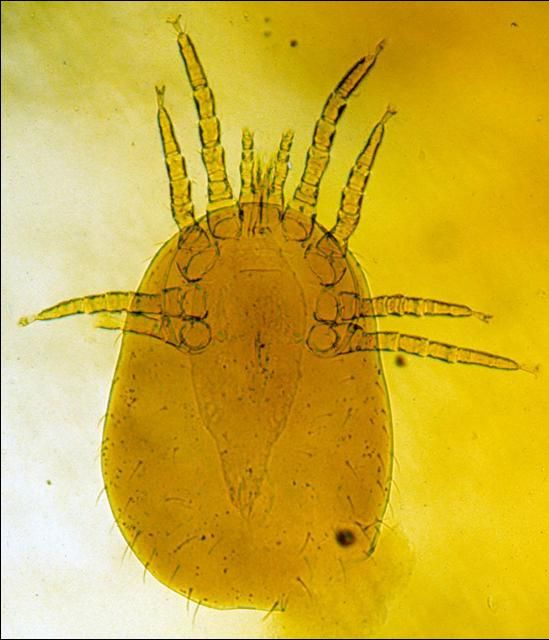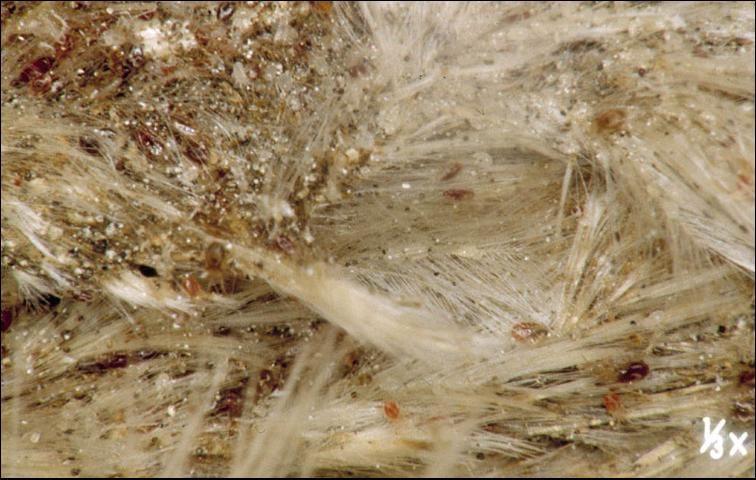The northern fowl mite (Figure 1) is the most important external parasite of poultry in Florida and is widely distributed throughout the state. This mite is found throughout many of the temperate regions of the world parasitizing domestic fowl and wild birds.

The northern fowl mite has been shown to cause economic damage on poultry farms by causing anemia, lower egg production and even death to birds. Also of considerable importance, the mites will bite humans (egg handlers) causing itching and irritation to the skin.
Life Cycle
There are 4 stages in the mite life cycle—egg, larva, nymph, and adult. The adult female mite lays eggs on the host bird. Depending on the temperature and humidity, the eggs will hatch in 1 to 2 days. The larvae which hatch from the egg do not feed, and molt to the nymphal stage in about 8 hours. The nymph has biting mouthparts and pierces the bird's skin for a blood meal. The nymphs mature to adults in 4–7 days. Adult female mites take a blood meal and complete egg-laying in 2 days. The number of eggs laid average 2–5 per female mite. The complete life cycle from egg to egg-laying female can take place in 5–7 days or longer depending on temperature and humidity. Adult mites spend most of their lives on the host, but will also wander to the eggs and rafters. The mite prefers to remain on the host in the vicinity of the vent, although the back is also a preferred site.

Credit: J. F. Butler, University of Florida
Although female mites do not lay large numbers of eggs, mite populations can rise rapidly after a bird has been initially infested. When conditions are optimal, newly infested birds may support mite populations in excess of 20,000 per bird in 9–10 weeks. Mite populations of approximately 200,000 per bird will cause death from blood loss or exsanguination.
Economic Importance
Infestations of large numbers of northern fowl mites can reduce egg production in healthy chickens by 10%. Small to moderate populations do not affect bird egg production although egg handlers may complain of bites and irritation because of the presence of mites.

Credit: J. F. Butler, University of Florida
Severe anemia and death may result from birds infested with large mite populations. Death is usually the result of blood loss from the bites of 200,000 or more mites per bird. Mite-stressed birds usually reduce food intake, lose weight rapidly, and exhibit a pale pink comb. The feathers will also darken due to the excrement from large numbers of mites. Scabbing may develop in the vent region.

Credit: J. F. Butler, University of Florida
Economically important populations of northern fowl mites normally occur from December through March in Florida. Mites prefer lower temperatures (65–68°F ambient) and lower relative humidities and these factors may partially explain the increase in mite problems around mid-winter.
Mites can survive for 2 to 3 weeks away from their host. Therefore, removing the birds from an infested house and replacing them 2 weeks later may not break the life cycle.
Transmission
Mites are normally transmitted from bird to bird by contact or by the mites simply crawling to new hosts. Mites may be introduced into a "clean" house by introduction of new infested birds, by wild birds, or from infected egg flats that are hauled from farm to farm. Northern fowl mites severely infest young wild birds in the nest. Young fledglings feeding in or around poultry farms may be an important factor in the transmission of mites from house to house.
Control
None of the recommended materials will kill the eggs of northern fowl mite. Since the mite will go through a generation in 7 days, it is necessary to re-treat the birds in 4–7 days to insure effective control. Some pesticides cannot be applied more often than once every 4 weeks or pesticide tolerances in the eggs will be exceeded. It is therefore advisable to alternate chemicals when scheduling miticiding operations.
Selected References
Arrends, J. J., S. H. Robertson and C. S. Payne. 1984. Impact of northern fowl mite on broiler breeder flocks in North Carolina. Poult. Sci. 63:1457-1461.
Combs, R. L., Jr. and J. L. Lancaster, Jr. 1965. The biology of the northern fowl mite. Fayetteville, AR: Agricultural Experiment Station, University of Arkansas; May, Report nr 138. 1-10 p.
DeVaney, J. A., B. W. Martin, and R. B Harvey. 1984. Factors affecting northern fowl mite populations on chickens: Effect of age of pullet at time of infestation and effect of caponizing roosters. Poult. Sci. 63:1327-1332.
Matthysse, J. G., C. J. Jones, and A. Purnasiri. 1974. Development of northern fowl mite: Populations on chickens, effects on the host, and immunology. Volume 4. Ithaca, NY: Cornell University Agricultural Experiment Station. p 1-39.
Mullen, G. R. and B. M. O'Connor. 2002. Mites (Acari), In: Medical and Veterinary Entomology, (G. R. Mullen and L. A. Durden, Eds.), pp. 449-517. Elsevier Science, San Diego, CA.
Mullens, B. A., N. C. Hinkle, L. J. Robinson, and C. E. Szijj. 2001. Dispersal of northern fowl mites, Ornithonyssus sylviarum, among hens in an experimental poultry house. J. Appl. Poultry Res.10: 60-64.
Owens, J. P. and B. A. Mullens. 2004. Influence of heat and vibration on the movement of the northern fowl mite (Acari: Macronyssidae). J. Med. Entomol. 41: 865-872.